Electric vehicle
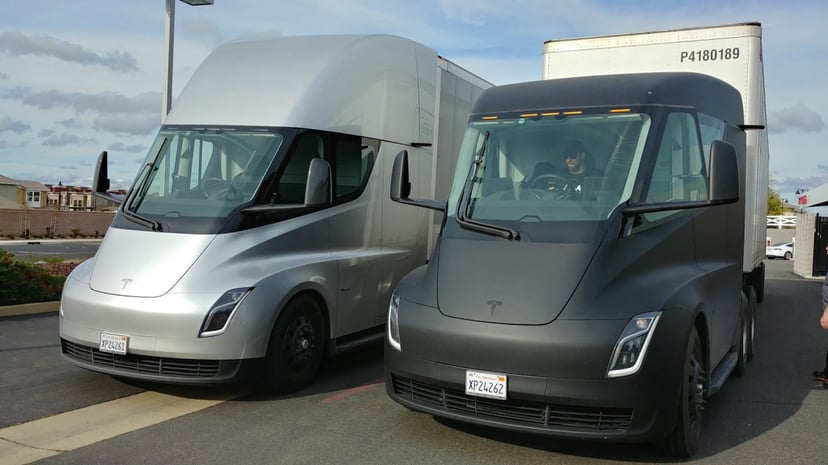
Electric vehicle

| Electric vehicles around the world(from top left): |
An electric vehicle, also called an EV, uses one or more electric motors or traction motors for propulsion. An electric vehicle may be powered through a collector system by electricity from off-vehicle sources, or may be self-contained with a battery, solar panels or an electric generator to convert fuel to electricity.[1] EVs include, but are not limited to, road and rail vehicles, surface and underwater vessels, electric aircraft and electric spacecraft.
EVs first came into existence in the mid-19th century, when electricity was among the preferred methods for motor vehicle propulsion, providing a level of comfort and ease of operation that could not be achieved by the gasoline cars of the time.
Modern internal combustion engines have been the dominant propulsion method for motor vehicles for almost 100 years, but electric power has remained commonplace in other vehicle types, such as trains and smaller vehicles of all types.
In the 21st century, EVs saw a resurgence due to technological developments, and an increased focus on renewable energy. A great deal of demand for electric vehicles developed and a small core of do-it-yourself (DIY) engineers began sharing technical details for doing electric vehicle conversions. Government incentives to increase adoptions were introduced, including in the United States and the European Union.[2][3]
Electric vehicles are expected to increase from 2% of global share in 2016 to 22% in 2030.[4]
| Electric vehicles around the world(from top left): |
History
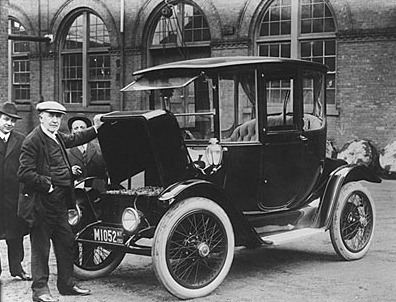
Edison and a 1914 Detroit Electric model 47 (courtesy of the National Museum of American History)

An EV and an antique car on display at a 1912 auto show
Electric motive power started in 1827, when Hungarian priest Ányos Jedlik built the first crude but viable electric motor, provided with stator, rotor and commutator, and the year after he used it to power a tiny car.[5] A few years later, in 1835, professor Sibrandus Stratingh of the University of Groningen, the Netherlands, built a small-scale electric car, and between 1832 and 1839 (the exact year is uncertain), Robert Anderson of Scotland invented the first crude electric carriage, powered by non-rechargeable primary cells.[6] Around the same period, early experimental electrical cars were moving on rails, too. American blacksmith and inventor Thomas Davenport built a toy electric locomotive, powered by a primitive electric motor, in 1835. In 1838, a Scotsman named Robert Davidson built an electric locomotive that attained a speed of four miles per hour (6 km/h). In England a patent was granted in 1840 for the use of rails as conductors of electric current, and similar American patents were issued to Lilley and Colten in 1847.[7]
The first mass-produced electric vehicles appeared in America in the early 1900s.
In 1902, "Studebaker Automobile Company" entered the automotive business with electric vehicles, though it also entered the gasoline vehicles market in 1904.
However, with the advent of cheap assembly line cars by Ford, electric cars fell to the wayside[8]
Due to the limitations of storage batteries at that time, electric cars did not gain much popularity, however electric trains gained immense popularity due to their economies and fast speeds achievable. By the 20th century, electric rail transport became commonplace. Over time their general-purpose commercial use reduced to specialist roles, as platform trucks, forklift trucks, ambulances,[9] tow tractors and urban delivery vehicles, such as the iconic British milk float; for most of the 20th century, the UK was the world's largest user of electric road vehicles.[10]
Electrified trains were used for coal transport, as the motors did not use precious oxygen in the mines. Switzerland's lack of natural fossil resources forced the rapid electrification of their rail network. One of the earliest rechargeable batteries – the nickel-iron battery – was favored by Edison for use in electric cars [175].
EVs were among the earliest automobiles, and before the preeminence of light, powerful internal combustion engines, electric automobiles held many vehicle land speed and distance records in the early 1900s. They were produced by Baker Electric, Columbia Electric, Detroit Electric, and others, and at one point in history out-sold gasoline-powered vehicles. In fact, in 1900, 28 percent of the cars on the road in the USA were electric. EVs were so popular that even President Woodrow Wilson and his secret service agents toured Washington, DC, in their Milburn Electrics, which covered 60–70 mi (100–110 km) per charge.[11]
A number of developments contributed to decline of electric cars.[12] Improved road infrastructure required a greater range than that offered by electric cars, and the discovery of large reserves of petroleum in Texas, Oklahoma, and California led to the wide availability of affordable gasoline/petrol, making internal combustion powered cars cheaper to operate over long distances.[13] Also internal combustion powered cars became ever easier to operate thanks to the invention of the electric starter by Charles Kettering in 1912,[14] which eliminated the need of a hand crank for starting a gasoline engine, and the noise emitted by ICE cars became more bearable thanks to the use of the muffler, which Hiram Percy Maxim had invented in 1897. As roads were improved outside urban areas electric vehicle range could not compete with the ICE. Finally, the initiation of mass production of gasoline-powered vehicles by Henry Ford in 1913 reduced significantly the cost of gasoline cars as compared to electric cars.[6]
In the 1930s, National City Lines, which was a partnership of General Motors, Firestone, and Standard Oil of California purchased many electric tram networks across the country to dismantle them and replace them with GM buses. The partnership was convicted of conspiring to monopolize the sale of equipment and supplies to their subsidiary companies, but were acquitted of conspiring to monopolize the provision of transportation services.
Experimentation

This 1973 photo of a charging station in Seattle shows an AMC Gremlin modified to take electric power; it had a range of about 50 miles on one charge.
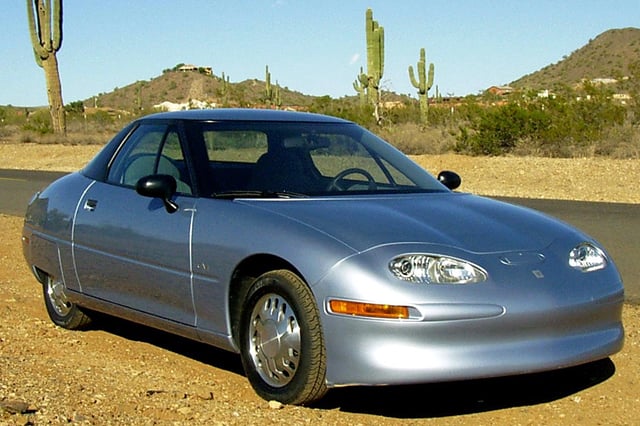
General Motors EV1 electric car (1996–1998), story told in movie Who Killed the Electric Car?
In January 1990, General Motors' President introduced its EV concept two-seater, the "Impact", at the Los Angeles Auto Show.
That September, the California Air Resources Board mandated major-automaker sales of EVs, in phases starting in 1998.
From 1996 to 1998 GM produced 1117 EV1s, 800 of which were made available through three-year leases.[16]
Chrysler, Ford, GM, Honda, and Toyota also produced limited numbers of EVs for California drivers.
In 2003, upon the expiration of GM's EV1 leases, GM discontinued them.
The discontinuation has variously been attributed to:
the auto industry's successful federal court challenge to California's zero-emissions vehicle mandate,
a federal regulation requiring GM to produce and maintain spare parts for the few thousands EV1s and
the success of the oil and auto industries' media campaign to reduce public acceptance of EVs.
A movie made on the subject in 2005–2006 was titled Who Killed the Electric Car? and released theatrically by Sony Pictures Classics in 2006. The film explores the roles of automobile manufacturers, oil industry, the U.S. government, batteries, hydrogen vehicles, and consumers, and each of their roles in limiting the deployment and adoption of this technology.
Ford released a number of their Ford Ecostar delivery vans into the market. Honda, Nissan and Toyota also repossessed and crushed most of their EVs, which, like the GM EV1s, had been available only by closed-end lease. After public protests, Toyota sold 200 of its RAV EVs to eager buyers; they later sold at over their original forty-thousand-dollar price. This lesson did not go unlearned; BMW of Canada sold off a number of Mini EVs when their Canadian testing ended.
The production of the Citroën Berlingo Electrique stopped in September 2005.
Reintroduction
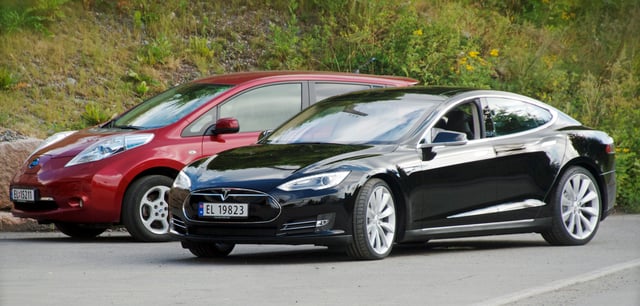
As of January 2018, the world's two best selling all-electric cars in history are the Nissan Leaf (left), with 300,000 in global sales[20] and the Tesla Model S (right), with over 200,000 in global sales.[21]
During the last few decades, environmental impact of the petroleum-based transportation infrastructure, along with the fear of peak oil, has led to renewed interest in an electric transportation infrastructure.[17] EVs differ from fossil fuel-powered vehicles in that the electricity they consume can be generated from a wide range of sources, including fossil fuels, nuclear power, and renewable sources such as tidal power, solar power, hydropower, and wind power or any combination of those. The carbon footprint and other emissions of electric vehicles varies depending on the fuel and technology used for electricity generation.[17][19] The electricity may then be stored on board the vehicle using a battery, flywheel, or supercapacitors. Vehicles making use of engines working on the principle of combustion can usually only derive their energy from a single or a few sources, usually non-renewable fossil fuels. A key advantage of hybrid or plug-in electric vehicles is regenerative braking, which recovers kinetic energy, typically lost during friction braking as heat, as electricity restored to the on-board battery.
As of March 2018, there are some 45 series production highway-capable all-electric cars available in various countries. As of early December 2015, the Leaf, with 200,000 units sold worldwide, was the world's top-selling highway-capable all-electric car of all time, followed by the Tesla Model S with global deliveries of about 100,000 units.[22] Leaf global sales achieved the 300,000 unit milestone in January 2018.[20]
As of May 2015, more than 500,000 highway-capable all-electric passenger cars and light utility vehicles had been sold worldwide since 2008, out of total global sales of about 850,000 light-duty plug-in electric vehicles.[23][24] As of May 2015, the United States had the largest fleet of highway-capable plug-in electric vehicles in the world, with about 335,000 highway legal plug-in electric cars sold in the country since 2008, and representing about 40% of the global stock.[25][26] California is the largest plug-in car regional market in the country, with almost 143,000 units sold between December 2010 and March 2015, representing over 46% of all plug-in cars sold in the U.S.[27][28][29][30] Cumulative global sales of all-electric cars and vans passed the 1 million unit milestone in September 2016.[31]
Norway is the country with the highest market penetration per capita in the world, with four plug-in electric vehicles per 1000 inhabitants in 2013.[32] In March 2014, Norway became the first country where over 1 in every 100 passenger cars on the roads is a plug-in electric.[33][34] In 2016, 29% of all new car sales in the country were battery-powered or plug-in hybrids.[35] Norway also had the world's largest plug-in electric segment market share of total new car sales, 13.8% in 2014, up from 5.6% in 2013.[25][36] In June 2016, Andorra became the second country in this list, with a 6% of market share combining electric vehicles and plug-in hybrids[37] due to a strong public policy providing multiple advantages.[38] As of May 2015, there were 58,989 plug-in electric vehicles registered in Norway, consisting of 54,160 all-electric vehicles and 4,829 plug-in hybrids.[39] By the end of 2016, Norway's 100,000th battery-powered car was sold.[35]
By some estimates electric vehicles sales may constitute almost a third of new-car sales by the end of 2030.[40]
Electricity sources

Electric bus in Santa Barbara, California

An electric locomotive at Brig, Switzerland

A passenger train, taking power through a third rail with return through the traction rails
There are many ways to generate electricity, of varying costs, efficiency and ecological desirability.
Connection to generator plants
direct connection to generation plants as is common among electric trains, trolley buses, and trolley trucks (See also : overhead lines, third rail and conduit current collection)
Online Electric Vehicle collects power from electric power strips buried under the road surface through electromagnetic induction
Onboard generators and hybrid EVs
(See articles on diesel-electric and gasoline-electric hybrid locomotion for information on EVs using also combustion engines).
generated on-board using a diesel engine: diesel-electric locomotive
generated on-board using a fuel cell: fuel cell vehicle
generated on-board using nuclear energy: nuclear submarines and aircraft carriers
renewable sources such as solar power: solar vehicle
It is also possible to have hybrid EVs that derive electricity from multiple sources.
Such as:
on-board rechargeable electricity storage system (RESS) and a direct continuous connection to land-based generation plants for purposes of on-highway recharging with unrestricted highway range [43]
on-board rechargeable electricity storage system and a fueled propulsion power source (internal combustion engine): plug-in hybrid
Another form of chemical to electrical conversion is fuel cells, projected for future use.
For especially large EVs, such as submarines, the chemical energy of the diesel-electric can be replaced by a nuclear reactor. The nuclear reactor usually provides heat, which drives a steam turbine, which drives a generator, which is then fed to the propulsion. Nuclear Power
A few experimental vehicles, such as some cars and a handful of aircraft use solar panels for electricity.
Onboard storage
| Vehicle type | Fuel used |
|---|---|
| All-petroleum vehicle | Most use of petroleum |
| Regular hybrid electric vehicle | Less use of petroleum, but unable to be plugged in |
| Plug-in hybrid vehicle | Less use of petroleum, residual use of electricity |
| All-electric vehicle(BEV, AEV) | Most use of electricity |
These systems are powered from an external generator plant (nearly always when stationary), and then disconnected before motion occurs, and the electricity is stored in the vehicle until needed.
Full Electric Vehicles (FEV).
[44] Power storage methods include: chemical energy stored on the vehicle in on-board batteries: Battery electric vehicle (BEV) typically with a lithium-ion battery kinetic energy storage: flywheels static energy stored on the vehicle in on-board electric double-layer capacitors
Batteries, electric double-layer capacitors and flywheel energy storage are forms of rechargeable on-board rechargeable electricity storage system|electrical storage. By avoiding an intermediate mechanical step, the energy conversion efficiency can be improved over the hybrids already discussed, by avoiding unnecessary energy conversions. Furthermore, electro-chemical batteries conversions are easy to reverse, allowing electrical energy to be stored in chemical form.
Lithium-ion battery
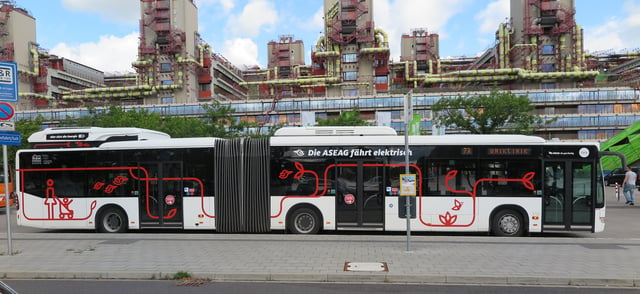
Battery electric bus powered with lithium-ion batteries
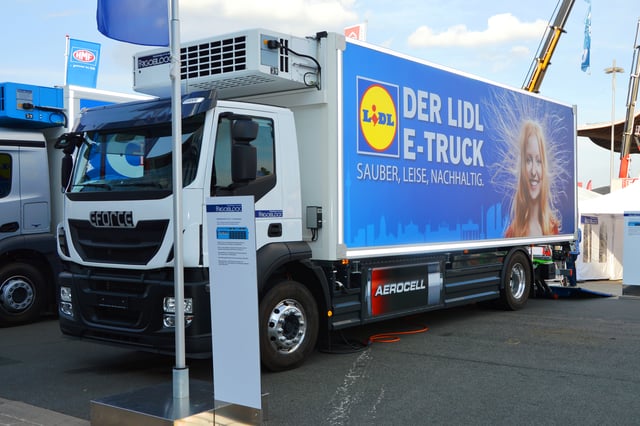
Electric truck e-Force One
Most electric vehicles use lithium-ion batteries (Li-Ions or LIBs). Lithium ion batteries have higher energy density, longer life span and higher power density than most other practical batteries. Complicating factors include safety, durability, thermal breakdown and cost. Li-ion batteries should be used within safe temperature and voltage ranges in order to operate safely and efficiently.[45]
Increasing the battery's lifespan decreases effective costs.
One technique is to operate a subset of the battery cells at a time and switching these subsets.[45]
In the past, Nickel Metal Hydride batteries were used among EV cars such as those made by General Motors.[47] These battery types are considered out-dated due to their tendencies to self discharge in the heat.[48] Also the batteries' patent was held by Chevron which created a problem for their widespread development.[49] These detractors coupled with their high cost has led to Lithium-ion (Li-Ion) batteries leading as the predominant battery for EVs.[50]
Lithium-ion batteries' price is constantly decreasing, thus, making electric vehicles more affordable and attractive on the market.[51]
Electric motor
The power of a vehicle's electric motor, as in other vehicles, is measured in kilowatts (kW).
100 kW is roughly equal to 134 horsepower, but electric motors can deliver their maximum torque over a wide RPM range. This means that the performance of a vehicle with a 100 kW electric motor exceeds that of a vehicle with a 100 kW internal combustion engine, which can only deliver its maximum torque within a limited range of engine speed.
Energy is lost during the process of converting the electrical energy to mechanical energy.
Approximately 90% of the energy from the battery is converted to mechanical energy, the losses being in the motor and drivetrain.[52]
Usually, direct current (DC) electricity is fed into a DC/AC inverter where it is converted to alternating current (AC) electricity and this AC electricity is connected to a 3-phase AC motor.
For electric trains, forklift trucks, and some electric cars, DC motors are often used. In some cases, universal motors are used, and then AC or DC may be employed. In recent production vehicles, various motor types have been implemented, for instance: Induction motors within Tesla Motor vehicles and permanent magnet machines in the Nissan Leaf and Chevrolet Bolt.[53]
Vehicle types
It is generally possible to equip any kind of vehicle with an electric powertrain.
Ground vehicles
Plug-in electric vehicle
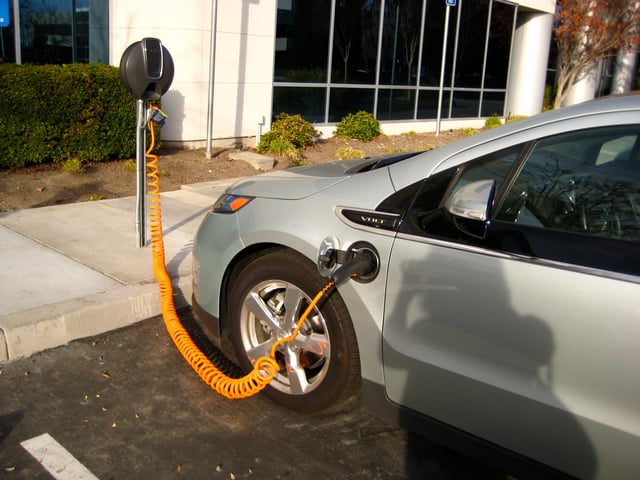
The Chevrolet Volt is the world's top selling plug-in hybrid of all time. Global Volt/Ampera family sales passed the 100,000 unit milestone in October 2015.[54]
A plug-in electric vehicle (PEV) is any motor vehicle that can be recharged from any external source of electricity, such as wall sockets, and the electricity stored in the Rechargeable battery packs drives or contributes to drive the wheels. PEV is a subcategory of electric vehicles that includes all-electric or battery electric vehicles (BEVs), plug-in hybrid vehicles, (PHEVs), and electric vehicle conversions of hybrid electric vehicles and conventional internal combustion engine vehicles.[55][56][57]
Cumulative global sales of highway-capable light-duty pure electric vehicles passed one million units in total, globally, in September 2016.[31][58] Cumulative global sales of plug-in cars and utility vans totaled over 2 million by the end of 2016, of which 38% were sold in 2016,[59] and the 3 million milestone was achieved in November 2017.[60]
As of January 2018, the world's top selling plug-in electric cars is the Nissan Leaf, with global sales of more than 300,000 units.[20] As of June 2016, it was followed by the all-electric Tesla Model S with about 129,400 units sold worldwide, the Chevrolet Volt plug-in hybrid, which together with its sibling the Opel/Vauxhall Ampera has combined global sales of about 117,300 units, the Mitsubishi Outlander P-HEV with about 107,400 units, and the Prius Plug-in Hybrid with over 75,400 units.[61]
Hybrid EVs
A hybrid electric vehicle combines a conventional (usually fossil fuel-powered) powertrain with some form of electric propulsion. As of April 2016, over 11 million hybrid electric vehicles have been sold worldwide since their inception in 1997. Japan is the market leader with more than 5 million hybrids sold, followed by the United States with cumulative sales of over 4 million units since 1999, and Europe with about 1.5 million hybrids delivered since 2000.[62] Japan has the world's highest hybrid market penetration. By 2013 the hybrid market share accounted for more than 30% of new standard passenger car sold, and about 20% new passenger vehicle sales including kei cars.[63] Norway ranks second with a hybrid market share of 6.9% of new car sales in 2014, followed by the Netherlands with 3.7%[64]
Global hybrid sales are by Toyota Motor Company with more than 9 million Lexus and Toyota hybrids sold as of April 2016,[65] followed by Honda Motor Co., Ltd. with cumulative global sales of more than 1.35 million hybrids as of June 2014,[66][67][68] Ford Motor Corporation with over 424,000 hybrids sold in the United States through June 2015,[69][70][71][72][73] and the Hyundai Group with cumulative global sales of 200,000 hybrids as of March 2014, including both Hyundai Motor Company and Kia Motors hybrid models.[74] As of April 2016, worldwide hybrid sales are led by the Toyota Prius liftback, with cumulative sales of over 3.7 million units. The Prius nameplate has sold more than 5.7 million hybrids up to April 2016.[75]
On- and off-road EVs
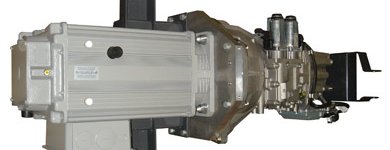
An electric powertrain used by Power Vehicle Innovation for trucks or buses[76]
EVs are on the road in many functions, including electric cars, electric trolleybuses, electric buses, battery electric buses, electric trucks, electric bicycles, electric motorcycles and scooters, personal transporters, neighborhood electric vehicles, golf carts, milk floats, and forklifts. Off-road vehicles include electrified all-terrain vehicles and tractors.
Railborne EVs
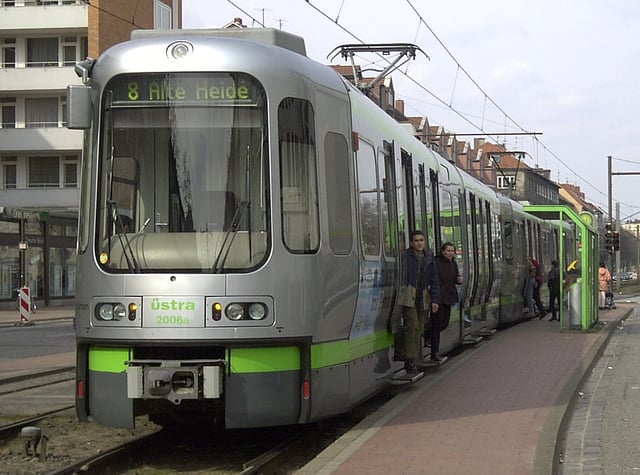
A streetcar (or Tram) drawing current from a single overhead wire through a pantograph.
The fixed nature of a rail line makes it relatively easy to power EVs through permanent overhead lines or electrified third rails, eliminating the need for heavy onboard batteries. Electric locomotives, electric trams/streetcars/trolleys, electric light rail systems, and electric rapid transit are all in common use today, especially in Europe and Asia.
Since electric trains do not need to carry a heavy internal combustion engine or large batteries, they can have very good power-to-weight ratios. This allows high speed trains such as France's double-deck TGVs to operate at speeds of 320 km/h (200 mph) or higher, and electric locomotives to have a much higher power output than diesel locomotives. In addition, they have higher short-term surge power for fast acceleration, and using regenerative brakes can put braking power back into the electrical grid rather than wasting it.
Maglev trains are also nearly always EVs.[77]
Space rover vehicles
Manned and unmanned vehicles have been used to explore the Moon and other planets in the solar system. On the last three missions of the Apollo program in 1971 and 1972, astronauts drove silver-oxide battery-powered Lunar Roving Vehicles distances up to 35.7 kilometers (22.2 mi) on the lunar surface.[78] Unmanned, solar-powered rovers have explored the Moon and Mars.[79][80]
Airborne EVs
Since the beginning of the dawn of the time of aviation, electric power for aircraft has received a great deal of experimentation.
Currently flying electric aircraft include manned and unmanned aerial vehicles.
Seaborne EVs
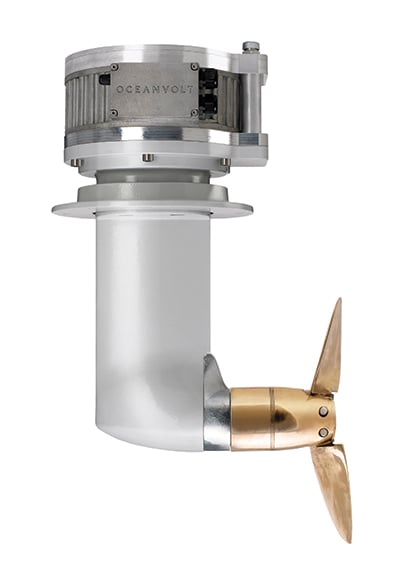
Oceanvolt SD8.6 electric saildrive motor
Electric boats were popular around the turn of the 20th century. Interest in quiet and potentially renewable marine transportation has steadily increased since the late 20th century, as solar cells have given motorboats the infinite range of sailboats. Electric motors can and have also been used in sailboats instead of traditional diesel engines.[81] Electric ferries operate routinely.[82] Submarines use batteries (charged by diesel or gasoline engines at the surface), nuclear power, fuel cells[83] or Stirling engines to run electric motor-driven propellers.
Electrically powered spacecraft
Electric power has a long history of use in spacecraft.[84][85] The power sources used for spacecraft are batteries, solar panels and nuclear power. Current methods of propelling a spacecraft with electricity include the arcjet rocket, the electrostatic ion thruster, the Hall effect thruster, and Field Emission Electric Propulsion. A number of other methods have been proposed, with varying levels of feasibility.
Energy and motors
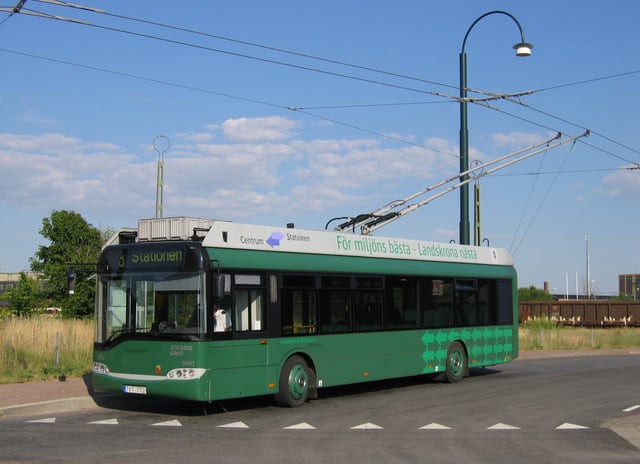
A trolleybus uses two overhead wires to provide electric current supply and return to the power source

An electric bus at Lucerne
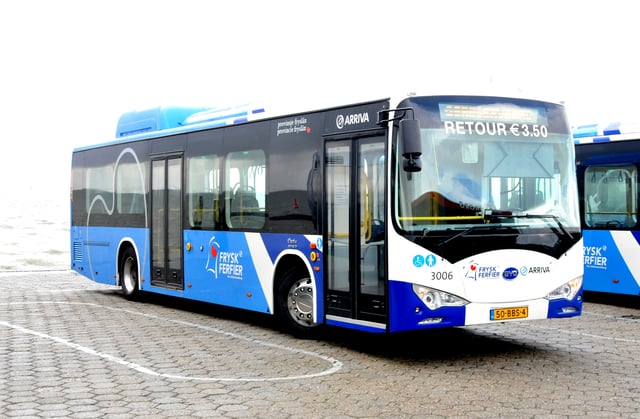
Battery electric bus by BYD in the Netherlands
Most large electric transport systems are powered by stationary sources of electricity that are directly connected to the vehicles through wires.
Electric traction allows the use of regenerative braking, in which the motors are used as brakes and become generators that transform the motion of, usually, a train into electrical power that is then fed back into the lines. This system is particularly advantageous in mountainous operations, as descending vehicles can produce a large portion of the power required for those ascending. This regenerative system is only viable if the system is large enough to utilise the power generated by descending vehicles.
In the systems above, motion is provided by a rotary electric motor. However, it is possible to "unroll" the motor to drive directly against a special matched track. These linear motors are used in maglev trains which float above the rails supported by magnetic levitation. This allows for almost no rolling resistance of the vehicle and no mechanical wear and tear of the train or track. In addition to the high-performance control systems needed, switching and curving of the tracks becomes difficult with linear motors, which to date has restricted their operations to high-speed point to point services.
Properties
Components
The type of battery, the type of traction motor and the motor controller design vary according to the size, power and proposed application, which can be as small as a motorized shopping cart or wheelchair, through pedelecs, electric motorcycles and scooters, neighborhood electric vehicles, industrial fork-lift trucks and including many hybrid vehicles.
Energy sources
Although EVs have few direct emissions, all rely on energy created through electricity generation, and will usually emit pollution and generate waste, unless it is generated by renewable source power plants. Since EVs use whatever electricity is delivered by their electrical utility/grid operator, EVs can be made more or less efficient, polluting and expensive to run, by modifying the electrical generating stations. This would be done by an electrical utility under a government energy policy, in a timescale negotiated between utilities and government.
Fossil fuel vehicle efficiency and pollution standards take years to filter through a nation's fleet of vehicles. New efficiency and pollution standards rely on the purchase of new vehicles, often as the current vehicles already on the road reach their end-of-life. Only a few nations set a retirement age for old vehicles, such as Japan or Singapore, forcing periodic upgrading of all vehicles already on the road.
EVs will take advantage of whatever environmental gains happen when a renewable energy generation station comes online, a fossil-fuel power station is decommissioned or upgraded. Conversely, if government policy or economic conditions shifts generators back to use more polluting fossil fuels and internal combustion engine vehicles (ICEVs), or more inefficient sources, the reverse can happen. Even in such a situation, electrical vehicles are still more efficient than a comparable amount of fossil fuel vehicles. In areas with a deregulated electrical energy market, an electrical vehicle owner can choose whether to run his electrical vehicle off conventional electrical energy sources, or strictly from renewable electrical energy sources (presumably at an additional cost), pushing other consumers onto conventional sources, and switch at any time between the two.
Batteries
Efficiency
Electromagnetic radiation
Electromagnetic radiation from high performance electrical motors has been claimed to be associated with some human ailments, but such claims are largely unsubstantiated except for extremely high exposures.[88] Electric motors can be shielded within a metallic Faraday cage, but this reduces efficiency by adding weight to the vehicle, while it is not conclusive that all electromagnetic radiation can be contained.
Charging
Grid capacity
If a large proportion of private vehicles were to convert to grid electricity it would increase the demand for generation and transmission, and consequent emissions.[89] However, overall energy consumption and emissions would diminish because of the higher efficiency of EVs over the entire cycle.
In the USA it has been estimated there is already nearly sufficient existing power plant and transmission infrastructure, assuming that most charging would occur overnight, using the most efficient off-peak base load sources.[90]
In the UK however, things are different.
While National Grid's high-voltage electricity transmission system can currently manage the demand of 1 million electric cars, Steve Holliday (CEO National Grid PLC) said, "penetration up and above that becomes a real issue.
Local distribution networks in cities like London may struggle to balance their grids if drivers choose to all plug in their cars at the same time."
Charging stations

BYD e6
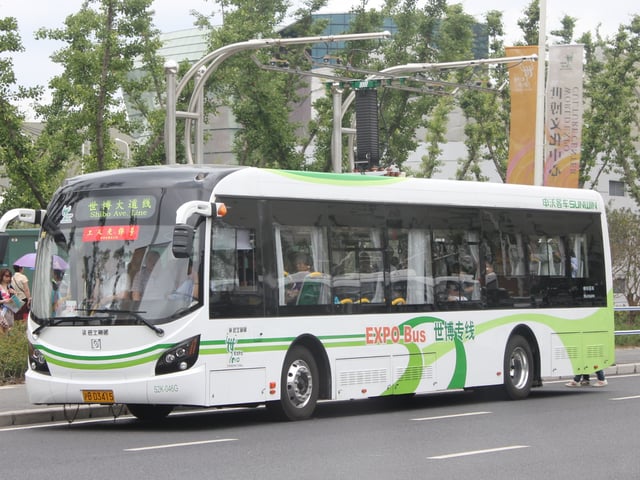
A Sunwin electric bus in Shanghai at a charging station
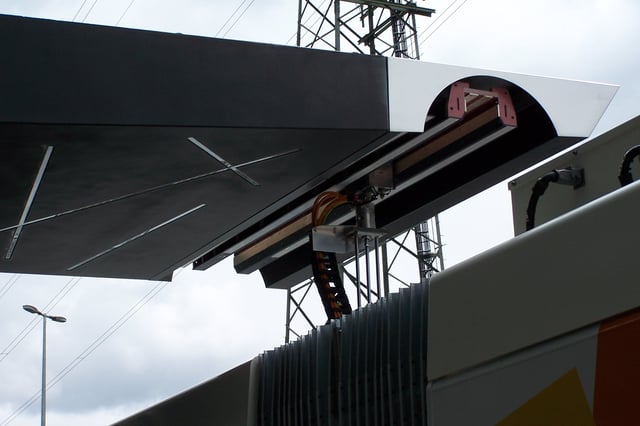
A battery electric bus charging station in Geneva, Swiss
EVs typically charge from conventional power outlets or dedicated charging stations, a process that typically takes hours, but can be done overnight and often gives a charge that is sufficient for normal everyday usage.
However, with the widespread implementation of electric vehicle networks within large cities in the UK and Europe, EV users can plug in their cars whilst at work and leave them to charge throughout the day, extending the possible range of commutes and eliminating range anxiety.
A recharging system that avoids the need for a cable is Curb Connect, patented in 2012[91] by Dr Gordon Dower.
In this system, electrical contacts are fitted into curbs, such as angle parking spaces on city streets.
When a suitably authorized vehicle is parked so that its front end overhangs the curb, the curb contacts become energized and charging occurs.
Another proposed solution for daily recharging is a standardized inductive charging system such as Evatran's Plugless Power. Benefits are the convenience of parking over the charge station and minimized cabling and connection infrastructure.[92][93][94] Qualcomm is trialling such a system in London in early 2012.[95][96]
Yet another proposed solution for the typically less frequent, long distance travel is "rapid charging", such as the Aerovironment PosiCharge line (up to 250 kW) and the Norvik MinitCharge line (up to 300 kW). Ecotality is a manufacturer of Charging Stations and has partnered with Nissan on several installations. Battery replacement is also proposed as an alternative, although no OEMs including Nissan/Renault have any production vehicle plans. Swapping requires standardization across platforms, models and manufacturers. Swapping also requires many times more battery packs to be in the system.
According to Department of Energy research conducted at Pacific Northwest National Laboratory, 84% of existing vehicles could be switched over to plug-in hybrids without requiring any new grid infrastructure.[97] In terms of transportation, the net result would be a 27% total reduction in emissions of the greenhouse gases carbon dioxide, methane, and nitrous oxide, a 31% total reduction in nitrogen oxides, a slight reduction in nitrous oxide emissions, an increase in particulate matter emissions, the same sulfur dioxide emissions, and the near elimination of carbon monoxide and volatile organic compound emissions (a 98% decrease in carbon monoxide and a 93% decrease in volatile organic compounds).[97] The emissions would be displaced away from street level, where they have "high human-health implications."[97]
Battery swapping
Instead of recharging EVs from electric socket, batteries could be mechanically replaced at special stations in a couple of minutes (battery swapping).
Batteries with greatest energy density such as metal-air fuel cells usually cannot be recharged in purely electric way. Instead, some kind of metallurgical process is needed, such as aluminum smelting and similar.
Silicon-air, aluminum-air and other metal-air fuel cells look promising candidates for swap batteries.[98][99] Any source of energy, renewable or non-renewable, could be used to remake used metal-air fuel cells with relatively high efficiency.
Investment in infrastructure will be needed.
The cost of such batteries could be an issue, although they could be made with replaceable anodes and electrolyte.
Chassis swapping
Instead of replacing batteries, it is possible to replace the entire chassis (including the batteries, electric motor and wheels) of an electric Modular vehicle.
Such a system was patented in 2000 by Dr Gordon Dower and three road-licensed prototypes have been built by the Ridek Corporation in Point Roberts, Washington.[100] Dower proposed that an individual might own only the body (or perhaps a few different style bodies) for their vehicle, and would lease the chassis from a pool, thereby reducing the depreciation costs associated with vehicle ownership.
Other in-development technologies
Conventional electric double-layer capacitors are being worked to achieve the energy density of lithium ion batteries, offering almost unlimited lifespans and no environmental issues. High-K electric double-layer capacitors, such as EEStor's EESU, could improve lithium ion energy density several times over if they can be produced. Lithium-sulphur batteries offer 250 Wh/kg.[101] Sodium-ion batteries promise 400 Wh/kg with only minimal expansion/contraction during charge/discharge and a very high surface area.[102] Researchers from one of the Ukrainian state universities claim that they have manufactured samples of pseudocapacitor based on Li-ion intercalation process with 318 Wh/kg specific energy, which seem to be at least two times improvement in comparison to typical Li-ion batteries.[103]
Safety
The United Nations in Geneva (UNECE) has adopted the first international regulation (Regulation 100) on safety of both fully electric and hybrid electric cars, with the intent of ensuring that cars with a high voltage electric power train, such as hybrid and fully EVs, are as safe as combustion-powered cars. The EU and Japan have already indicated that they intend to incorporate the new UNECE Regulation in their respective rules on technical standards for vehicles[104]
There is a growing concern about the safety of EVs, given the demonstrated tendency of the Lithium-ion battery, most promising for EV use because of its high energy density, to overheat, possibly leading to fire or explosion, especially when damaged in a crash.
The U.S. National Highway Traffic Safety Administration opened a defect investigation of the Chevy Volt on 25 November 2011 amid concerns over the risk of battery fires in a crash. At that time, automotive consulting firm CNW Marketing Research reported a decline in consumer interest in the Volt, citing the fires as having made an impact on consumer perception.[105] Consumer response impelled GM to make safety enhancements to the battery system in December, and the NHTSA closed its investigation on 20 January 2012, finding the matter satisfactorily resolved with "no discernible defect trend" remaining. The agency also announced it has developed interim guidance to increase awareness and identify appropriate safety measures regarding electric vehicles for the emergency response community, law enforcement officers, tow truck operators, storage facilities and consumers.[106][107]
Advantages and disadvantages of EVs
Environmental
EVs release no tail pipe air pollutants at the place where they are operated.
They also typically generate less noise pollution than an internal combustion engine vehicle, whether at rest or in motion.[108] The energy that electric and hybrid cars consume is usually generated by means that have environmental impacts. Nevertheless, adaptation of EVs would have a significant net environmental benefit, except in a few countries that continue to rely on older coal fired power plants for the bulk of their electricity generation throughout the life of the car.[109][110][111]
There are special kind of electric vehicles named SAFA TEMPO in Nepal that help lower the pollution created by vehicles.[112] These vehicles are powered by electricity – usually charged batteries – rather than oil or gas and currently heavily promoted by the government to facilitate environmental and vehicle management issues.
Electric motors don't require oxygen, unlike internal combustion engines; this is useful for submarines and for space rovers.
A study by Cambridge Econometrics shows the potential air pollution benefits of EVs.
According to one of the scenarios in the study, Europe would be on track to reduce CO2 emissions from cars by 88% by 2050.
The associated technology improvements would cut toxic nitrogen oxides (NOx) from cars from around 1.3 million tonnes per year to around 70,000 tonnes per year.[113]
Mechanical
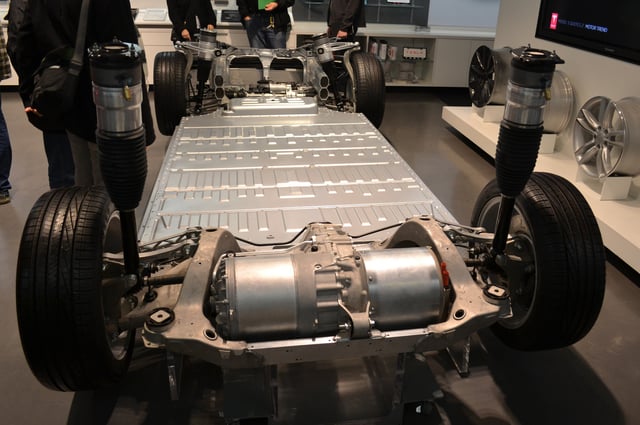
Tesla Model S chassis with drive motor
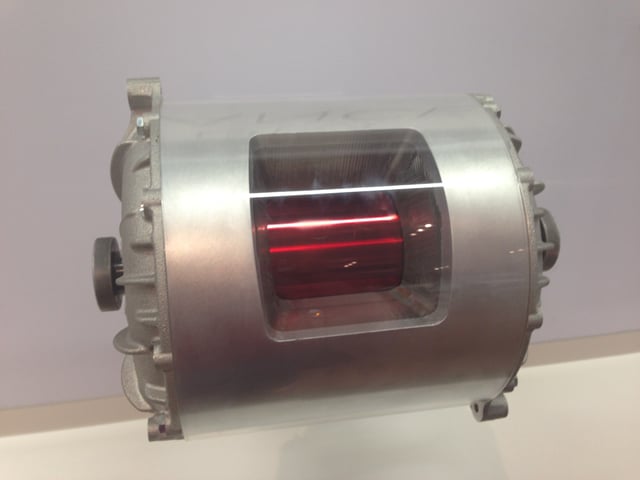
Cutaway view of a Tesla Model S drive motor
Electric motors are mechanically very simple and often achieve 90% energy conversion efficiency[114] over the full range of speeds and power output and can be precisely controlled. They can also be combined with regenerative braking systems that have the ability to convert movement energy back into stored electricity. This can be used to reduce the wear on brake systems (and consequent brake pad dust) and reduce the total energy requirement of a trip. Regenerative braking is especially effective for start-and-stop city use.
They can be finely controlled and provide high torque from rest, unlike internal combustion engines, and do not need multiple gears to match power curves.
This removes the need for gearboxes and torque converters.
EVs provide quiet and smooth operation and consequently have less noise and vibration than internal combustion engines.[108] While this is a desirable attribute, it has also evoked concern that the absence of the usual sounds of an approaching vehicle poses a danger to blind, elderly and very young pedestrians. To mitigate this situation, automakers and individual companies are developing systems that produce warning sounds when EVs are moving slowly, up to a speed when normal motion and rotation (road, suspension, electric motor, etc.) noises become audible.[115]
Energy resilience
Electricity can be produced from a variety of sources, therefore it gives the greatest degree of energy resilience.[116]
Energy efficiency
EV 'tank-to-wheels' efficiency is about a factor of 3 higher than internal combustion engine vehicles.[108] Energy is not consumed while the vehicle is stationary, unlike internal combustion engines which consume fuel while idling. However, looking at the well-to-wheel efficiency of EVs, their total emissions, while still lower, are closer to an efficient gasoline or diesel in most countries where electricity generation relies on fossil fuels.[117][118][119]
Well-to-wheel efficiency of an EV has less to do with the vehicle itself and more to do with the method of electricity production.
A particular EV would instantly become twice as efficient if electricity production were switched from fossil fuel to a wind or tidal primary source of energy.
Thus, when "well-to-wheels" is cited, one should keep in mind that the discussion is no longer about the vehicle, but rather about the entire energy supply infrastructure – in the case of fossil fuels this should also include energy spent on exploration, mining, refining, and distribution.
The lifecycle analysis of EVs shows that even when powered by the most carbon intensive electricity in Europe, they emit less greenhouse gases than a conventional diesel vehicle.[120]
Cost of recharge
The cost of operating an EV varies wildly depending on location.
In some parts of the world, an EV costs less to drive than a comparable gas-powered vehicle, as long as the higher initial purchase price is not factored in.
In the US, in states which have a tiered electricity rate schedule, "fuel" for EVs today costs owners significantly more than fuel for a comparable gas-powered vehicle.
A 2011 study done by Purdue University found that in California most users already reach the third pricing tier for electricity each month, and adding an EV could push them into the fourth or fifth (highest, most expensive) tier, meaning that they will be paying in excess of $0.45 per kWh for electricity to recharge their vehicle.
At this price, which is higher than the average electricity price in the US, it is dramatically more expensive to drive a pure-EV than it is to drive a traditional pure-gas powered vehicle.
"The objective of a tiered pricing system is to discourage consumption.
It's meant to get you to think about turning off your lights and conserving electricity.
In California, the unintended consequence is that plug-in hybrid cars won't be economical under this system," said Tyner (the author), whose findings were published in the online version of the journal Energy Policy.[121]
Stabilization of the grid
Since EVs can be plugged into the electric grid when not in use, there is a potential for battery-powered vehicles to even cut the demand for electricity by feeding electricity into the grid from their batteries during peak use periods (such as midafternoon air conditioning use) while doing most of their charging at night, when there is unused generating capacity.[122][89] This vehicle-to-grid (V2G) connection has the potential to reduce the need for new power plants, as long as vehicle owners do not mind reducing the life of their batteries, by being drained by the power company during peak demand. It is also proved that an electric vehicle parking lot was able to well play the role of an agent that provides demand response.[123]
Furthermore, our current electricity infrastructure may need to cope with increasing shares of variable-output power sources such as wind and solar PV.
This variability could be addressed by adjusting the speed at which EV batteries are charged, or possibly even discharged.
Some concepts see battery exchanges and battery charging stations, much like gas/petrol stations today.
Clearly these will require enormous storage and charging potentials, which could be manipulated to vary the rate of charging, and to output power during shortage periods, much as diesel generators are used for short periods to stabilize some national grids.[124][125]
Range
Electric vehicles may have shorter range compared to Internal Combustion Engines, however, the price per mile of electric vehicles is falling.[126][127] Most owners opt to charge their vehicles primarily at their houses while not in use due to their typically slower charging times, and added convenience.[128]
Heating of EVs
In cold climates, considerable energy is needed to heat the interior of a vehicle and to defrost the windows.
With internal combustion engines, this heat already exists as waste combustion heat diverted from the engine cooling circuit.
This process offsets the greenhouse gases' external costs. If this is done with battery EVs, the interior heating requires extra energy from the vehicles' batteries. Although some heat could be harvested from the motor or motors and battery, their greater efficiency means there is not as much waste heat available as from a combustion engine.
However, for vehicles which are connected to the grid, battery EVs can be preheated, or cooled, with little or no need for battery energy, especially for short trips.
Newer designs are focused on using super-insulated cabins which can heat the vehicle using the body heat of the passengers. This is not enough, however, in colder climates as a driver delivers only about 100 W of heating power. A heat pump system, capable of cooling the cabin during summer and heating it during winter, seems to be the most practical and promising way of solving the thermal management of the EV. Ricardo Arboix[129] introduced (2008) a new concept based on the principle of combining the thermal-management of the EV-battery with the thermal-management of the cabin using a heat pump system. This is done by adding a third heat-exchanger, thermally connected with the battery-core, to the traditional heat pump/air conditioning system used in previous EV-models like the GM EV1 and Toyota RAV4 EV. The concept has proven to bring several benefits, such as prolonging the life-span of the battery as well as improving the performance and overall energy-efficiency of the EV.[130][131][132][133]
Electric public transit efficiency
Shifts from private to public transport (train, trolleybus, personal rapid transit or tram) have the potential for large gains in efficiency in terms of an individual's distance traveled per kWH.
Research shows people do prefer trams,[134] because they are quieter and more comfortable and perceived as having higher status.[135] Therefore, it may be possible to cut liquid fossil fuel consumption in cities through the use of electric trams. Trams may be the most energy-efficient form of public transportation, with rubber wheeled vehicles using 2/3 more energy than the equivalent tram, and run on electricity rather than fossil fuels.
In terms of net present value, they are also the cheapest—Blackpool trams are still running after 100-years, but combustion buses only last about 15-years.
Incentives and promotion
In May 2017, India was the first to announce plans to sell only electric vehicles by 2030.[136][137] Prime Minister Narendra Modi's government kickstarted the ambitious plan by floating a tender to purchase 10,000 electric vehicles,[138] hailed as "the world's single-largest EV procurement initiative."[139] Along with fulfilling the urgent need to keep air pollution in check, the Indian government aims at reducing the petroleum import bill and running cost of vehicles. With nearly a third of all cars sold in 2017 of all new cars either fully electric or a hybrid, Norway is the world leader in the adoption of electric cars and pushes to sell only electric or hybrid cars by 2030. The other nations followed the lead, with France and UK announcing the plan to ban the sale of gas and diesel cars by 2040. Austria, China, Denmark, Germany, Ireland, Japan, the Netherlands, Portugal, Korea and Spain have also set official targets for electric car sales.
Many governments offer incentives to promote the use of electric vehicles, with the goals of reducing air pollution and oil consumption.
Some incentives intend to increase purchases of electric vehicles by offsetting the purchase price with a grant.
Other incentives include lower tax rates or exemption from certain taxes, and investment in charging infrastructure.
In some states, car companies have partnered with local private utilities in order to provide large incentives on select electric vehicles.
For example, in the state of Florida, Nissan and NextEra Energy, a local energy company, are working together to offer $10,000 incentives on the all-electric 2017 Nissan Leaf.
In addition, the government offers electric vehicle incentives up to $7,500 to people who meet the qualifications outlined by the Federal Electric Vehicles Tax Credit.
A standard 2017 Nissan Leaf costs around $30,000.
As a result, Florida residents could purchase a new Leaf for less than half of the market value price.
San Diego's local private utility, San Diego Gas and Electric (SDG&E), offers its customers an electric vehicle incentive of $10,000 for a 2017 BMW i3.[141]
Sonoma Clean Power, the public utility that serves both Sonoma and Mendocino, offers its customers EV incentives up to $2,000 on a Volkswagen e-Golf.
In addition, Volkswagen offers an incentive of $7,000 towards the purchase of an e-Golf.
On top of these local incentives, and the federal tax credit, California residents can receive state incentives up to $2,500 in the form of state rebates.
Therefore, Sonoma Clean Power customers can potentially save up to $19,000 on an e-Wolf.[142]
In March 2018, NPR reported that demand for electricity in the U.S. had begun to decline.
The Tennessee Valley Authority projected a 13 percent drop in demand among the seven states it serves, which is "the first persistent decline in the federally owned agency's 85-year history." To combat this, companies in the utility sector launched programs to get more involved in the electric car market. For example, utility companies began to invest in electric vehicle charging infrastructure and to team up with automobile manufacturers to offer rebates to people who purchase electric vehicles.[143]
Future
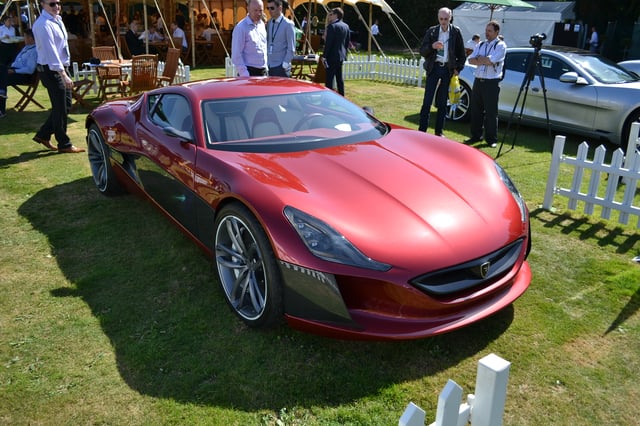
Rimac Concept One, electric supercar, since 2013. 0 to 100 km/h in 2.8 seconds, with a total output of 800 kW (1,073 hp)
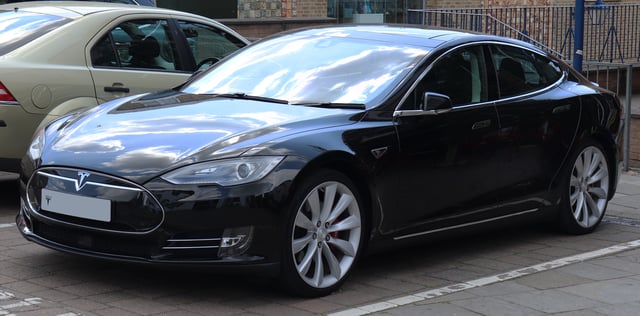
Tesla Model S, since 2012. 0 to 100 km/h in 2.5 seconds, recharging in 30 minutes to 80 percent, range 600 km
Over 9000 Londoners may die early every year from toxic air.
Transport is a major contributor to the problem, so the city plans to become Europe's ultra-low-emissions vehicle capital and achieve zero transport emissions by 2050.
A government-funded scheme is helping London's boroughs install over 1000 charge points across the city by the end of 2020.
Ferdinand Dudenhoeffer, head of the Centre of Automotive Research at the Gelsenkirchen University of Applied Sciences in Germany, said that "by 2025, all passenger cars sold in Europe will be electric or hybrid electric".[146]
Improved batteries
First, advances in lithium ion batteries, in large part driven by the consumer electronics industry, allow full-sized, highway-capable EVs to be propelled as far on a single charge as conventional cars go on a single tank of gasoline. Lithium batteries have been made safe, can be recharged in minutes instead of hours (see recharging time), and now last longer than the typical vehicle (see lifespan). The production cost of these lighter, higher-capacity lithium batteries is gradually decreasing as the technology matures and production volumes increase (see price history).
Rechargeable lithium-air batteries potentially offer increased range over other types and are a current topic of research.[149]
Battery management and intermediate storage
Another improvement is to decouple the electric motor from the battery through electronic control, employing supercapacitors to buffer large but short power demands and regenerative braking energy. The development of new cell types combined with intelligent cell management improved both weak points mentioned above. The cell management involves not only monitoring the health of the cells but also a redundant cell configuration (one more cell than needed). With sophisticated switched wiring it is possible to condition one cell while the rest are on duty.
Electric trucks

Electric Renault Midlum used by Nestlé.
Small electric trucks have been used for decades for specific and/or limited uses, such as Milk floats or the electric Renault Maxity.
Larger electric trucks have been made in the 2010s, such as prototypes of electric Renault Midlum tested in real conditions[150][151] and trucks by E-Force One and Emoss. Mercedes-Benz, a division of Daimler, began delivering ten eActros units to customers in September 2018 for a two-year real-world test.[152] DAF, a division of Paccar, delivered its first CF articulated truck to Jumbo for testing in December 2018.[153]
Fuso, a division of Daimler, began deliveries of the eCanter in 2017.[154] Freightliner, another division of Daimler, began delivering e-M2 trucks to Penske in December 2018, and will commercialise its larger e-Cascadia in 2019.[155] MAN, a division of Volkswagen AG, delivered its first unit of its e-TGM articulated truck to Porsche in December 2018, larger-scale production is scheduled to begin in 2019.[156]
Announced in 2017, the Tesla Semi, is expected to hit production lines in 2019.[159]
Hydrogen trains
Particularly in Europe, fuel-cell electric trains are gaining in popularity to replace Diesel-electric units. In Germany, several Länder have ordered Alstom Coradia iLINT trainsets, in service since 2018,[160] with France also planning to order trainsets.[161] The United Kingdom, the Netherlands, Denmark, Norway, Italy, Canada[160] and Mexico[162] are equally interested. In France, the SNCF plans to replace all its remaining Diesel-electric trains with hydrogen trains by 2035.[163] In the United Kingdom, Alstom announced in 2018 their plan to retrofit British Rail Class 321 trainsets with fuel cells.[164]
See also
Dual-mode vehicle
Electrathon
Electric Auto Association
Electric car use by country
Electric go-kart
Electric motorsport
Electric rickshaw
Electric-steam locomotive
Electric Vehicle Company
Electric vehicle conversion
Electric Vehicle Technical Center
Electric vehicle industry in India
Electrocar
Electromote
European Electric Motor Show
FIA Formula E Championship
Human–electric hybrid vehicle
Light electric vehicle
List of production battery electric vehicles
Plug-in electric vehicle fire incidents
Project Get Ready
Renewable energy by country
Superbus (transport)
Traction motor
Tribrid vehicle
Vehicle glider